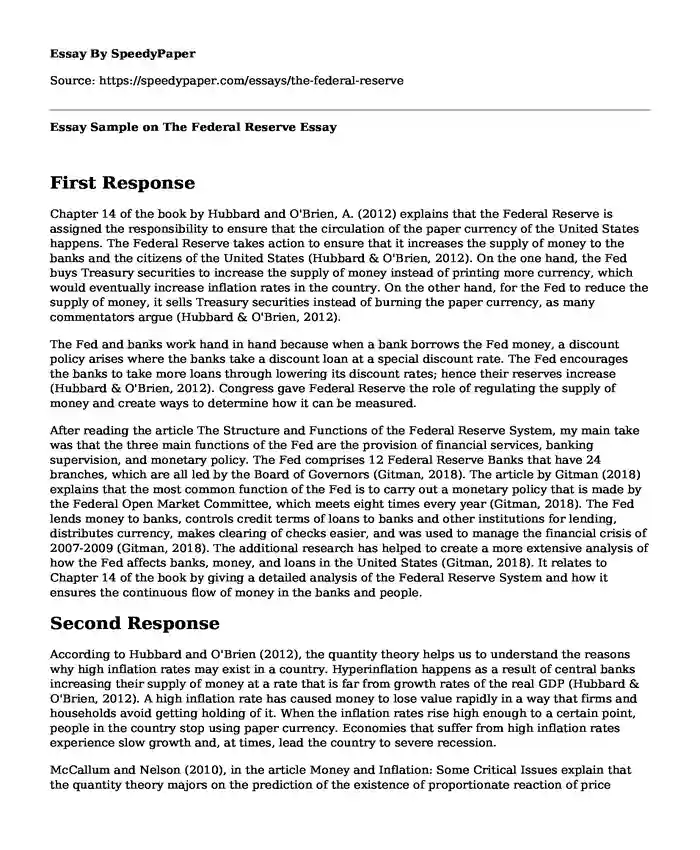
| Type of paper: | Essay |
| Categories: | Government Banking Budgeting Money |
| Pages: | 3 |
| Wordcount: | 742 words |
First Response
Chapter 14 of the book by Hubbard and O'Brien, A. (2012) explains that the Federal Reserve is assigned the responsibility to ensure that the circulation of the paper currency of the United States happens. The Federal Reserve takes action to ensure that it increases the supply of money to the banks and the citizens of the United States (Hubbard & O'Brien, 2012). On the one hand, the Fed buys Treasury securities to increase the supply of money instead of printing more currency, which would eventually increase inflation rates in the country. On the other hand, for the Fed to reduce the supply of money, it sells Treasury securities instead of burning the paper currency, as many commentators argue (Hubbard & O'Brien, 2012).
The Fed and banks work hand in hand because when a bank borrows the Fed money, a discount policy arises where the banks take a discount loan at a special discount rate. The Fed encourages the banks to take more loans through lowering its discount rates; hence their reserves increase (Hubbard & O'Brien, 2012). Congress gave Federal Reserve the role of regulating the supply of money and create ways to determine how it can be measured.
After reading the article The Structure and Functions of the Federal Reserve System, my main take was that the three main functions of the Fed are the provision of financial services, banking supervision, and monetary policy. The Fed comprises 12 Federal Reserve Banks that have 24 branches, which are all led by the Board of Governors (Gitman, 2018). The article by Gitman (2018) explains that the most common function of the Fed is to carry out a monetary policy that is made by the Federal Open Market Committee, which meets eight times every year (Gitman, 2018). The Fed lends money to banks, controls credit terms of loans to banks and other institutions for lending, distributes currency, makes clearing of checks easier, and was used to manage the financial crisis of 2007-2009 (Gitman, 2018). The additional research has helped to create a more extensive analysis of how the Fed affects banks, money, and loans in the United States (Gitman, 2018). It relates to Chapter 14 of the book by giving a detailed analysis of the Federal Reserve System and how it ensures the continuous flow of money in the banks and people.
Second Response
According to Hubbard and O'Brien (2012), the quantity theory helps us to understand the reasons why high inflation rates may exist in a country. Hyperinflation happens as a result of central banks increasing their supply of money at a rate that is far from growth rates of the real GDP (Hubbard & O'Brien, 2012). A high inflation rate has caused money to lose value rapidly in a way that firms and households avoid getting holding of it. When the inflation rates rise high enough to a certain point, people in the country stop using paper currency. Economies that suffer from high inflation rates experience slow growth and, at times, lead the country to severe recession.
McCallum and Nelson (2010), in the article Money and Inflation: Some Critical Issues explain that the quantity theory majors on the prediction of the existence of proportionate reaction of price levels. The theory also shows the unitary relationship that exists between money growth and inflation (McCallum & Nelson, 2010). Financial innovation can lead to negative relationships between inflation and the growth of money. The relationship that exists between inflation and money begins with discussions of the venerable quantity theory of money that is abbreviated as QTM (McCallum & Nelson, 2010).
It is associated with the equation MV=PY, where on the one hand, M is the measure of the nominal quantity of money, and V is the corresponding monetary velocity (McCallum & Nelson, 2010). On the other hand, Y is the physical output for each period or real transaction, while P is the price level. This article is essential in supporting the lesson because it explains how increased nominal rates lead to a spread of the rates of return on various securities and money (McCallum & Nelson, 2010). A shift in steady-state rates of inflation implies a fall in steady real interest rates making super-neutrality to increase and money to lose its value.
References
Gitman, L. (2018). The Federal Reserve System. Opentextbc.ca. https://opentextbc.ca/businessopenstax/chapter/the-federal-reserve-system/.
Hubbard, R., & O'Brien, A. (2012). Macroeconomics international edition (7th ed.). Pearson.
McCallum, B., & Nelson, E. (2010). Money and Inflation: Some Critical Issues. Federalreserve.gov. https://www.federalreserve.gov/pubs/feds/2010/201057/201057pap.pdf.
Cite this page
Essay Sample on The Federal Reserve. (2023, Aug 30). Retrieved from https://speedypaper.net/essays/the-federal-reserve
Request Removal
If you are the original author of this essay and no longer wish to have it published on the SpeedyPaper website, please click below to request its removal:
- Saving Service - Free Essay on Personal Finance
- Essay Sample on Visual Merchandising and Display Techniques
- Free Paper Sample on Sexual Assault and Substance Abuse Issues Within the Military
- Essay Sample on Comparing Nationalism in the Philippines and Burma
- Paper Example: Perpetrators' Treatment in the Saving and Loans Scandal in Arkansas
- Net Present Value (NPV) - Free Paper Sample
- Paper on Navigating Deflation: Australia's Response to Rising Real Interest Rates and Monetary Policies
Popular categories




